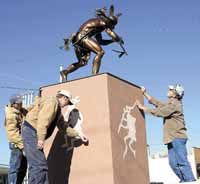| Gary Prazen, Danny Blanton and David Blanton put the final touches on the Kokopelli statue on 100 West Main Street in Price. In an effort to enhance downtown and encourage more foot traffic, the County Restaurant Tax Committee purchased the statue of the flute-playing Native American legend. |
Construction has wrapped up and Gary Prazen’s statue of Kokopelli officially came to rest on Price’s Main Street on Nov. 11.
However, the addition of the hunched-over flute player to the 100 West and Main intersection has left many area residents wondering why he has danced his way into Carbon County.
There are multiple interpretations of the Kokopelli legend. According to Kokopelli.com, the famous Native American figure has been attributed as a healer, a story teller, a prankster and even a god of fertility.
“Kokopelli embodies the true American southwest and dates back over 3,000 years ago, when the first petroglyphs were carved. Although his true origins are unknown, this traveling, flute-playing Casanova is a sacred figure to many southwestern Native Americans,” stated the Internet organization. “Carvings of this hunch-backed flute-playing figure have been found painted and carved into rock walls and boulders throughout the southwest.”
One legend has it that Kokopelli’s flute changed the winter season to spring, melting the snow and bringing around the rain for a successful harvest. When he visited a village, everyone would sing and dance through the night to the tune of his flute. The next morning every maiden in the village would be with child. It is also assumed that the hunch on his back depicted the sacks of seeds and songs he carried, pointed out Kokopelli.com.
But, according to Prazen, modern science has indicated that the hump on Kokopelli’s back could have been because he was afflicted by tuberculosis. The infectious disease of the lungs has been known to cause a humped back in people inflicted.
In Prazen’s sculpture of the mystical figure, though, the artist said he chose a more flattering representation of the alleged fertility god.
“I have chosen to portray Kokopelli idealistically as a handsome young man with a slightly humped back. A wander, a teacher of flutes and their music, a dancer and a womanizing rascal, a concept that most would like to relate to,” he commented.
To add credibility to the concept of Kokopelli being a flute player, Prazen consulted local flute maker Elias Perez. Perez, who is also an authority on ancient Indian flutes, indicated that Kokopelli is usually portrayed playing straight or horn type flutes, not common with the American Indian flutes which generally has a rising reed near the mouth end of the flute.
The straight and horn type flutes were more common with the southern Mexico and South American Indians. The locations of Kokopelli art, though, do no conflict with this idea.
“As an artist, I have been captivated by the legend and have done many variations of Kokopelli. I will probably do a lot more,” concluded Prazen.
The statue, which was purchased by the Restaurant Tax Commission, is part of an effort to bring more attention to downtown Price, according to Price Mayor Joe Piccolo.
“I think it’s a beautiful piece of art and it makes a very positive statement in our community about how we feel about art and our ancestors,” he commented.
Piccolo said he hopes that the statue will get people to stop and look at the downtown businesses and sights, as well as be a positive way to slow traffic down on the main thoroughfare.
The intersection where the statue resides has become a four way stop, rather than running on its old stop light system. Piccolo said he expects the change to actually increase the effectiveness of the intersection while still keeping motorists safe near the statue’s pedestal.
After the winter months, Price City will plant some native grasses and vegetation in the planters around the statue, pointed out Piccolo. Lighting will also be added to the underside of the statue, illuminating Kokopelli without the distracting effects of a spotlight. If the statue does not work at its current location, other places of interest in the city will be considered.
So, for the wandering Kokopelli, Price City has created a home on 100 West and Main Street. Time will tell if the magic that surrounds the Native American symbol will rub off on its residents and the remainder of the Carbon County community.

